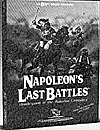
Designed by Kevin Zucker
Developed by J.A. Nelson
TSR/SPI Inc. PO Box 756, Lake Geneva,WI 53147
Released: April, 1985
Catalog No. 3016
Price: $20.00
Complexity: Beginner
Solitaire Suitability: Good
*****
Napoleon's Last Battles is an operational simulation of the Waterloo Campaign in which Napoleon's dream of empire was finally crushed. The individual battles of the campaign, Ligny, Quatre Bras, Wavre, and La Belle Alliance (Waterloo), are presented, as well as a campaign game that links the four battles into a grand battle game.
The game is a reprint of the original SPI version that was produced in 1977 and has been unavailable for some time. It is to the credit of TSR Inc. to reprint this classic wargame. No updating of the game was required, except for the errata, as it was a well-polished game when it first appeared.
The production of Napoleon's Last Battles is first class. The eye-catching box cover is one of the best to grace a war game box in some time. Each battle game has its own 22 X 17 inch map which is cut along specified edges to assemble the campaign map. The 400 counters (100 for each battle game) are well done, but their gloss finish produces glare and eyestrain when playing the game. TSR Inc. has changed its diecutting procedure and the counters are much easier to punch out. Setup is quick and easy as initial positions for the units are printed on the maps. The only criticism that I could find with the components was that the map sheets were not reprinted in state of the art graphics as in many of the S&T games.
Overall, the game is a bargain at $20.00. Napoleon's Last Battles is an excellent game. Ligny, Quatre Bras, and La Belle Alliance are finely balanced games. Wavre is slightly unbalanced but still a challenging contest for both players. The game system is easy to learn, uncomplicated, and adequately reflects the loss of unit cohesiveness from combat. The Combat Results Table (CRT) is a simple, bloody affair. Some may argue that it is too simplistic but it works within the restraints of the game system. The CRT reflects the concept of unit disorganization and withdrawal from combat due to personnel losses.
The game system is straightforward and consists of movement followed by a combat phase. Combat is mandatory between adjacent units. Artillery units are able to bombard from two hexes away. The campaign game adds a Command and Reorganization Phase prior to movement. Leader counters are used in the campaign game. Leaders allow combat units to enter zones of control and attack. They are also used to reorganize, or bring back, previously destroyed units at a reduced strength. The campaign game adds a new dimension to the basic battle games.
You must now operate your army as an integrated unit, not as a cluster of units moving around the battlefield, adding strength points to an attack just to reach a certain combat odds calculation. One is constrained to act in a somewhat historical role by keeping corps and divisions together to achieve desired results. The campaign game was innovative when it first appeared but now it is merely a rather typical Napoleonic game system. This is not an attack but merely shows how ahead of its time this system was when first introduced.
Other rules of note within the game system are rigid zones of control, special rules for chateaux hexes, demoralization rules, combined arms attack (odds column shift), and restrictions on the use of the French Imperial Guard, which imparts the actual historical use of the Guard. There is nothing complex here. You can start playing the game almost from the minute you open the box. The game system is simple, not simplistic. It all blends together into one of the best game systems ever created.
The game is fun to play and one can concentrate on strategy and tactics rather than bookkeeping, which seems to be the bane of most new war games released these days. Napoleon's Last Battles is a test of skill rather than an exercise in lucky die rolling when playing the campaign game. Careful planning of attacks is important and central to winning any of the battle games. The correct handling of Grouchys Corps and the crushing of the Prussians at Ligny are central to winning the more challenging campaign game. The French must keep the English and Prussians from linking up to win.
Victory is achieved through the demoralization of the opposing army. As losses mount the chance that the army will crack increases; this is reflected by set demoralization and disintegration levels. Once these levels are reached, the army routs and the battle is won. Destroying enemy units and exiting units off the map in certain battle games helps break the opponent's army.
Overall, Napoleon's Last Battles is one of the best buys on the hobby shelf these days. It combines strategy, tactics, excellent production standards, and great replay value all in an easily learned game. It can be played in an evening and is well worth playing again. in fact, the game can be addictive. It is easy to learn and is challenging enough for experienced gamers. If one were to own only one war game, this would probably be the one to own.
More War Game Reviews
-
Game Review: Napoleon's Last Battles: Quadrigame of the Waterloo Campaign
Game Review: Rome and the Barbarians
Game Review: Warhammer: Fantasy Battle Rules, Second Edition
Game Review: Lebensraum: The Campaign in the East, 1941-1945
Game Review: Pax Brittanica: The Colonial Era from 1880 to The Great War
Back to Table of Contents -- Game News #7
To Game News List of Issues
To MagWeb Master Magazine List
© Copyright 1985 by Dana Lombardy.
This article appears in MagWeb (Magazine Web) on the Internet World Wide Web.
Other military history articles and gaming articles are available at http://www.magweb.com